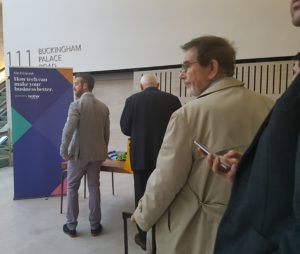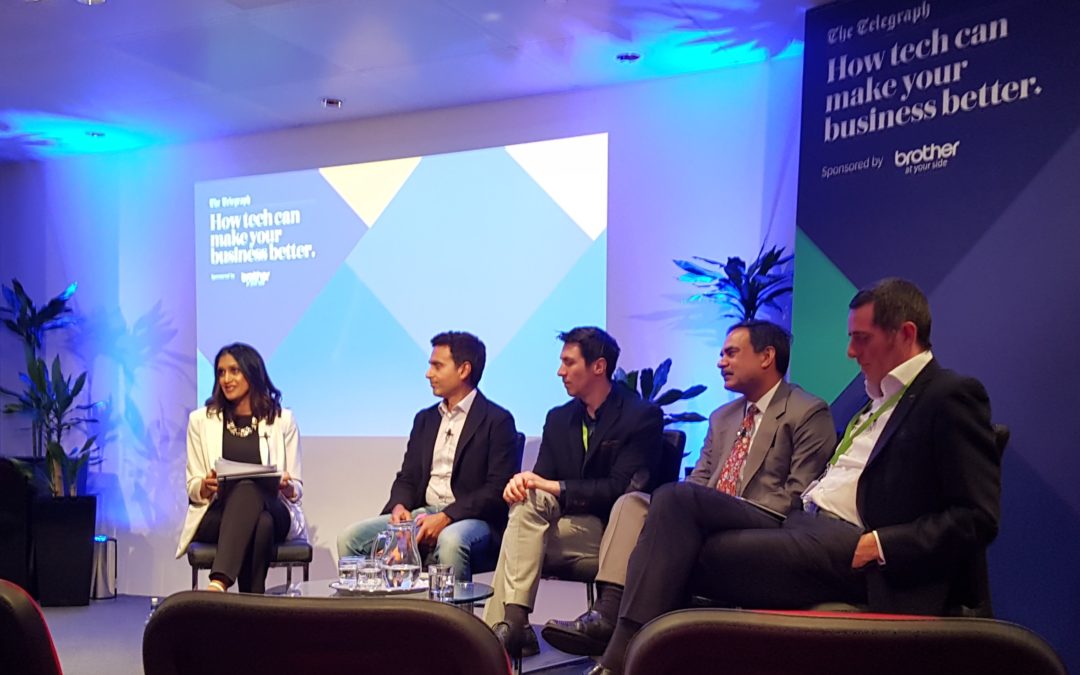September saw The Telegraph hosting a panel discussion at their London offices on using technology to transform smaller businesses. The panel included Raja Saggi (head of SMB marketing, UK and Ireland, Google), Luke Hughes (co-founder, Origym), Shashi Verma (Chief Technology Officer, Transport for London) and Phil Jones (Managing Director, UK, Brother).

“Companies are constantly inundated by new technology initiatives. But with their hefty price tag and time consuming roll out, can it really make your business better?“
Raja Saggi of Google started the discussion by pointing out that Marketing was the place where small businesses could punch above their weight, by using technology. Probably not a surprising comment, coming from the world’s largest provider of online advertising, but marketing has certainly been transformed by technology over the last decade, and with more change still to come. Phil Jones countered that with his recent experience of buying a house – a process that was still very much bogged down in traditional paper work and processes that haven’t really changed in decades. The business technology revolution is here, but it certainly isn’t evenly spread, with hugely different levels of progress between different sectors.
It is usually one of three things which drive change in a small business, according to Phil: moving, growing or breaking. Too often businesses don’t take a step back to reflect, look at their sector, and work out how to improve, before change is forced on them. Shashi (TfL) pointed out that there are really only two reasons for a lack of profitability in a business: Not enough demand or the costs of the business are too high. Solving either of those problems requires re-imagining your business, looking at who is leading in using technology, and being a fast follower of them. Following other people’s fire is fine, if you can’t find your own, leverage other people’s learning and mistakes. Luke (Origym) suggested looking at where technology can have the biggest impact in saving you time or reducing costs. What mundane activities can you automate? Know what problem you are trying to solve with the technology.
 Technology projects don’t have the best reputation, as Shashi pointed out, the only thing more common than a bad technology implementation is a very bad technology implementation. Of course, it doesn’t have to be that way, but unless you start with the people and focus on the problem, you aren’t going to get to the right solution. Shashi eloquently explained that businesses tend to focus on improving the things they can measure, rather than improving the things that matter. For example, the way that most companies operate employee expenses has completely changed in the last decade. For most businesses this may have reduced the need for one or two back office staff, but it has also cost them dearly in terms of the availability, productivity and motivation of their (usually expensive) sales teams!
Technology projects don’t have the best reputation, as Shashi pointed out, the only thing more common than a bad technology implementation is a very bad technology implementation. Of course, it doesn’t have to be that way, but unless you start with the people and focus on the problem, you aren’t going to get to the right solution. Shashi eloquently explained that businesses tend to focus on improving the things they can measure, rather than improving the things that matter. For example, the way that most companies operate employee expenses has completely changed in the last decade. For most businesses this may have reduced the need for one or two back office staff, but it has also cost them dearly in terms of the availability, productivity and motivation of their (usually expensive) sales teams!
How to get it right? Phil Jones says spend more time defining (and understanding) your problem. Understand the cultural issues that will impact on the implementation of the technology, and any cultural changes that will be required to make the new technology a success. Check that old assumptions still hold true, and if those old assumptions are no longer true, transform how you work. Shashi told the story behind train tickets, which was a fascinating example, which caused me to go and investigate further.
Tickets have meet in use a very long time, but they were revolutionised by the railway system. There was a need to account for the takings, so rather than just issuing paper tickets, as had been done for the Stage Coaches before them, so in the 1840’s Thomas Edmondson invented the idea of pre-printed tickets with serial numbers. These acted as a way to ensure that dishonest railway clerks didn’t pocket the train fares, since the unsold tickets could be reconciled with takings at the end of each day, enabling checks to be made on revenues. Of course, in today’s age of electronic payments, such a system is redundant – payments are made from the customers directly to the bank, enabling revenues to be accounted for. So, if we eliminate tickets, how can we revolutionise ticketing? We have the answer in London’s Oyster card system, which was born out of bringing new technology to this thinking.
What has changed in your business, and what has changed in the available technologies? Are the requirements that are now redundant, that might have opened up opportunities to transform your business? Or are there new technologies that can solve problems that were previously too hard to address? Don’t wait until you move, grow or break before you take the time to stop and reflect on those opportunities.

